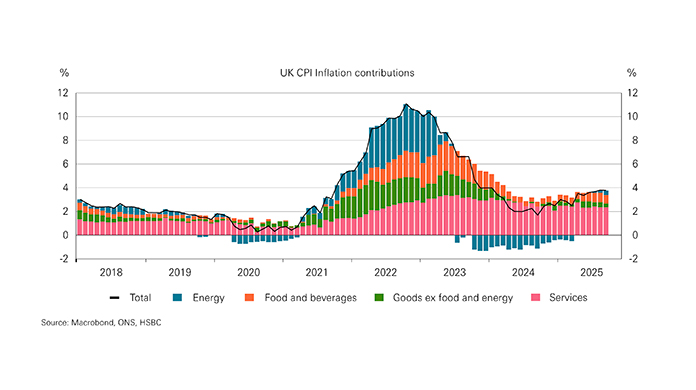- 3 minutes
- Article

- Support
- Economic Reports
- Market Research
UK in Focus: Essential economic news for businesses
UK economic data points to a more stable environment and inflation reported a lower-than-expected peak. Meanwhile the BoE leaves interest rates unchanged but signals further cuts are likely, though timing is more uncertain.
Some better news, from a low base
The bar is low for good news on the UK economy and while the uncertainty around the upcoming Autumn Budget persists, the latest UK data appeared, at least, to show some stabilisation in the economy. The PMIs surprised to the upside in October, consumer confidence held at its 2025 average, and despite stagnant GDP growth in August and July, we expect the economy to have grown over Q3 as a whole. Albeit at a slower pace than in the first two quarters of 2025.
On the inflation side, the expected jump in the inflation rate for September did not materialise. Headline CPI rate was unchanged at 3.8% y-o-y, the downside surprise relative to expectations was helped by broad based disinflation across the basket of goods and services. However, a lack of disinflation in restaurants and hotels, and a still elevated services inflation rate of 4.7% y-o-y in September, is a concern and may point to a more prolonged pass-through of higher labour costs. More positively, private sector pay growth has slowed and labour market data signals a further moderation. So while the outright decline in payrolled employees appears to no longer be gathering pace, various surveys continue to point to weak labour demand.
A Bank of England divided
The soft demand backdrop and still elevated inflation continue to put the Monetary Policy Committee (MPC) at odds on policy decisions. Bank Rate was unchanged at 4.00% in the November meeting, however, a vote split of 5-4 alongside individual commentary on each MPC member’s decisions only highlighted the uncertainty over the path of rate cuts. Such a divided committee likely leaves the Governor, with the deciding vote, given his more balanced views on the risks and outlook.
The committee’s central view is that inflation has peaked at 3.8% in September, and a subdued demand environment and soft labour market should see a gradual normalisation in pay growth; private sector pay grew 4.4% 3m/yr to August. On the upside, inflation expectations remain elevated (chart 3) and there is uncertainty as to their role coupled with structural changes in the labour market in future pay growth, that could prevent inflation returning to target sustainably.
On the downside, interest rates remain restrictive, consumer confidence is low, and weakness in household consumption may persist. The BoE noted that such a scenario could see inflation fall quicker than expected. Then there is the looming Autumn Budget and expected fiscal tightening, a risk yet to be accounted for by the BoE.
Download a PDF version of the report
Analyst Certification
The following analyst(s), economist(s), or strategist(s) who is(are) primarily responsible for this report, including any analyst(s) whose name(s) appear(s) as author of an individual section or sections of the report and any analyst(s) named as the covering analyst(s) of a subsidiary company in a sum-of-the-parts valuation certifies(y) that the opinion(s) on the subject security(ies) or issuer(s), any views or forecasts expressed in the section(s) of which such individual(s)is(are) named as author(s), and any other views or forecasts expressed herein, including any views expressed on the back page of the research report, accurately reflect their personal view(s) and that no part of their compensation was, is or will be directly or indirectly related to the specific recommendation(s) or views contained in this research report: Emma Wilks.
Important disclosures
This document has been prepared and is being distributed by the Research Department of HSBC and is intended solely for the clients of HSBC and is not for publication to other persons, whether through the press or by other means.
This document is for information purposes only and it should not be regarded as an offer to sell or as a solicitation of an offer to buy the securities or other investment products mentioned in it and/or to participate in any trading strategy. Advice in this document is general and should not be construed as personal advice, given it has been prepared without taking account of the objectives, financial situation or needs of any particular investor. Accordingly, investors should, before acting on the advice, consider the appropriateness of the advice, having regard to their objectives, financial situation and needs. If necessary, seek professional investment and tax advice.
Certain investment products mentioned in this document may not be eligible for sale in some states or countries, and they may not be suitable for all types of investors. Investors should consult with their HSBC representative regarding the suitability of the investment products mentioned in this document and take into account their specific investment objectives, financial situation or particular needs before making a commitment to purchase investment products.
The value of and the income produced by the investment products mentioned in this document may fluctuate, so that an investor may get back less than originally invested. Certain high-volatility investments can be subject to sudden and large falls in value that could equal or exceed the amount invested. Value and income from investment products may be adversely affected by exchange rates, interest rates, or other factors. Past performance of a particular investment product is not indicative of future results.
HSBC and its affiliates will from time to time sell to and buy from customers the securities/instruments, both equity and debt (including derivatives) of companies covered in HSBC Research on a principal or agency basis or act as a market maker or liquidity provider in the securities/instruments mentioned in this report.
Analysts, economists, and strategists are paid in part by reference to the profitability of HSBC which includes investment banking, sales & trading, and principal trading revenues.
Whether, or in what time frame, an update of this analysis will be published is not determined in advance.
For disclosures in respect of any company mentioned in this report, please see the most recently published report on that company available at www.hsbcnet.com/research. HSBC Private Banking clients should contact their Relationship Manager for queries regarding other research reports. In order to find out more about the proprietary models used to produce this report, please contact the authoring analyst.
- This report is dated as at 07 November 2025.
- All market data included in this report are dated as at close 06 November 2025, unless a different date and/or a specific time of day is indicated in the report.
- HSBC has procedures in place to identify and manage any potential conflicts of interest that arise in connection with its Research business. HSBC's analysts and its other staff who are involved in the preparation and dissemination of
Research operate and have a management reporting line independent of HSBC's Investment Banking business. Information Barrier procedures are in place between the Investment Banking, Principal Trading, and Research businesses
to ensure that any confidential and/or price sensitive information is handled in an appropriate manner. - You are not permitted to use, for reference, any data in this document for the purpose of (i) determining the interest payable, or other sums due, under loan agreements or under other financial contracts or instruments, (ii) determining the price at which a financial instrument may be bought or sold or traded or redeemed, or the value of a financial instrument, and/or (iii) measuring the performance of a financial instrument or of an investment fund




